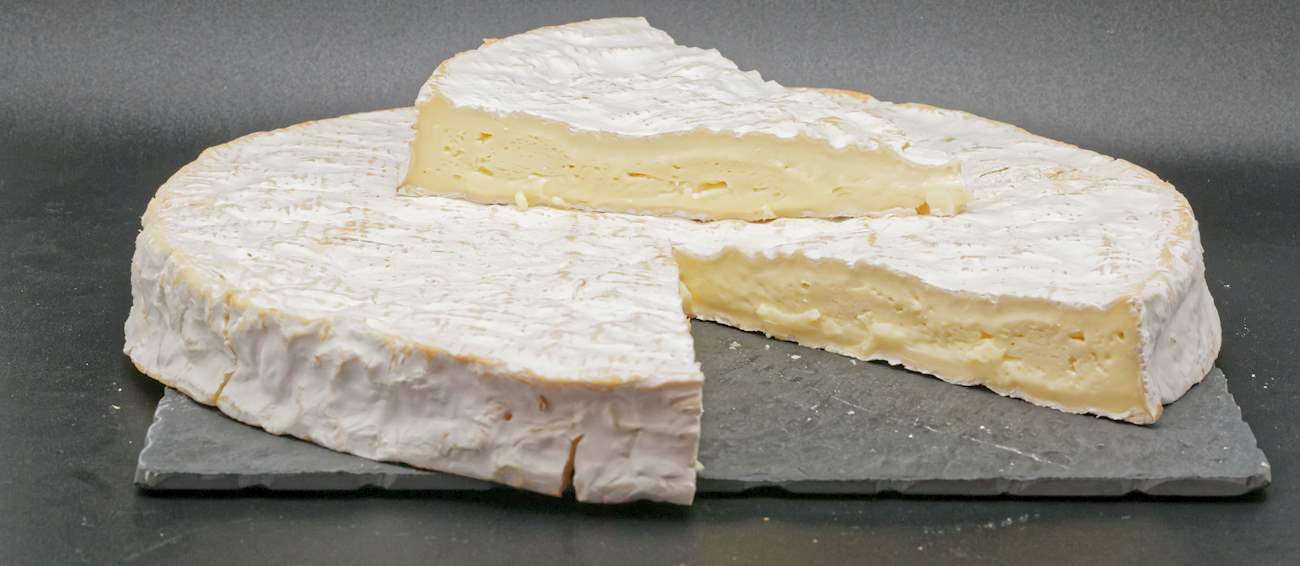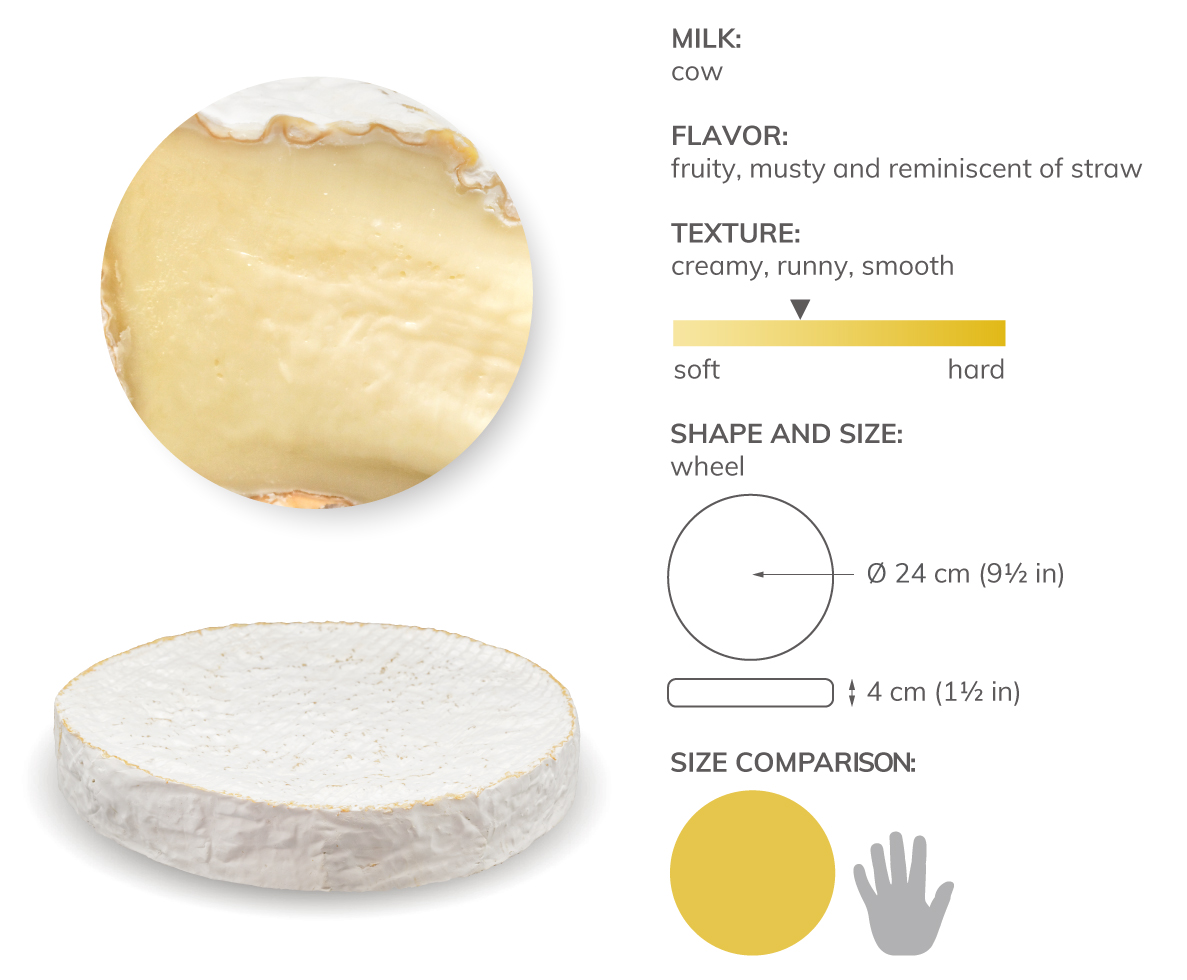Best Francilien Bloomy Rind Cheese Types
Brie de Melun is a soft, flat-formed cheese made from unpasteurized cow's milk in the areas of Aube and Yonne and the Brie region of Île-de-France. This Brie is even smaller than its widely popular cousin Brie de Meaux and it is also stronger and saltier in taste.
Its body is golden yellow and has a white, moldy rind with dispersed reddish strokes. Brie de Melun needs more time to be produced than Brie de Meaux, and it also matures for quite a longer period (4-8 weeks). The flavor of the cheese is fruity, musty and reminiscent of straw.
Pair with
Brie de Meaux is a soft French cheese made from cow's milk. The flat cheese has a delicate rind covered in white mold. It matures in cellars on straw mats in the Île-de-France area near Paris for at least four weeks. This particular variety of Brie is the most famous of all, and in the past, it has been known as the cheese of royalty and well-off people.
It is important to let the Brie reach room temperature before consumption in order to fully appreciate its range of flavors - moldy, mushroomy, nutty, and fruity. The cheese is commonly used in French culinary specialties such as Galettes briardes and Bouchées á la reine au Brie.
Pair with
THE BEST Brie de Meaux Cheeses
Domaine des Trente Arpents
Brie de Meaux Fermier Rothschild
Concours International de Lyon - Gold 2025

Named after the eponymous commune in the Seine-et-Marne region in France, where it was first produced, Coulommiers is a soft cheese made from cow’s milk. It is characterized by a fat content of 40%, a creamy texture, and a buttery, nutty flavor.
The cheese also has a bloomy, edible rind. It is recommended to pair it with pears, berries, or apples after a big meal. Although it is similar to Brie, Coulommiers is smaller, thicker, and unfortunately, less popular.
Pair with
Fromage de Meaux is a traditional cheese and the pasteurized version of Brie de Meaux (made with raw milk). The cheese is made with pasteurized cow's milk, and it's left to age from 6 to 8 weeks before consumption. Underneath its velvety mold-ripened rind, the texture is soft, smooth, and buttery.
The aromas are cabbage-like and garlicky, while the flavors are rich and mushroomy. Fromage de Meaux must mature within the areas of Ile-de-France, Centre, Champagne-Ardenne, Lorraine, or Bourgogne. It's recommended to let the cheese sit at room temperature before it's enjoyed with crusty baguettes, pear jam, or crisp green apples.
Pair with
Boursault is a French soft-ripened triple-cream cheese. It's made from pasteurized cow's milk and hails from the region of Val-de-Marne. The cheese was invented by Henri Boursault in 1951, hence the name. Underneath the bloomy rind, the texture is smooth, creamy, and spreadable because is has a high-fat content.
The aroma is earthy and the flavors are buttery, seriously rich, nutty, salty, and citrusy. Boursault ages for 12 days, and it spends an additional month in its packaging. It's recommended to pair the cheese with pears, grapes, and light, fruity wines such as Vouvray.
Pair with
THE BEST Boursault Cheeses
Brie de Nangis is a French cheese hailing from Brie. Made from raw cow's milk, this Brie is one of the mildest and more buttery versions of the cheese. The texture is smooth and creamy, while the center is slightly chalky, but it becomes runny with aging, usually for 4 to 6 weeks.
The flavors are rich, mushroomy, vegetal, and slightly tangy from the rind, with hints of steamed cauliflower. It's recommended to pair it with a glass of Sauvignon Blanc or a bold red wine such as Merlot. Serve it with crusty bread or apple and rosemary jelly.
Pair with
Gratte-Paille is a French triple cream cheese produced in Tournan-en-Brie. The cheese is made from raw cow's milk and cream, and it's shaped into a loaf. It's left to mature for 6-8 weeks, and the more it ripens, the stronger the paste becomes.
Underneath its bloomy rind, the texture is creamy, silky, and airy. The cheese melts in the mouth with flavors that are salty, buttery, sweet, milky, and mushroomy, with hints of straw and nuts. The name Gratte-Paille refers to an ancient road near the fromagerie, where the bushes on the side of the road used to scruff the carriages that rode by.
Pair with
Brie noir or black brie is a French cheese with a distinctive dark color and a crumbly texture. The cheese is made from raw cow's milk. It ages for up to 2 years and develops an earthy, nutty, bitter, mushroomy, and acidic flavor.
Due to its sharp and intense flavors, many locals dunk it in coffee. It is believed that the cheese originated in the region of Seine-et-Marne, when people used to leave surplus brie to age a bit longer, so it became a staple for local laborers.
THE BEST Brie Noir Cheeses
Bayard gourmand is a traditional cheese that’s produced in Saint-Simeon in Seine-et-Marne. The cheese is made from raw cow’s milk. Underneath its thin bloomy rind, the texture is soft and creamy. The aromas are buttery, while the flavors are creamy, fresh, and milky.
Bayard gourmand is considered a dessert cheese because it pairs exceptionally well with apples, dried fruit, and nuts such as walnuts and hazelnuts.
Fougerus is a French cheese produced in the region of Seine-et-Marne. It is made with raw cow's milk from 20 farms in the region. The cheese has a bloomy rind which hides a soft and creamy texture undernath. After four weeks, when fully ripe, the texture should be runny and smooth.
The word fougerus is French for fern, referring to the fact that fern was originally placed on the cheese in order to hide unappealing blemishes which appeared on the cheese as it matured. However, the cheese was so aromatic and flavorful that ferns were always used on the cheese from then on.
Pair with
TasteAtlas food rankings are based on the ratings of the TasteAtlas audience, with a series of mechanisms that recognize real users and that ignore bot, nationalist or local patriotic ratings, and give additional value to the ratings of users that the system recognizes as knowledgeable. TasteAtlas Rankings should not be seen as the final global conclusion about food. Their purpose is to promote excellent local foods, instill pride in traditional dishes, and arouse curiosity about dishes you haven’t tried.












